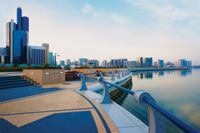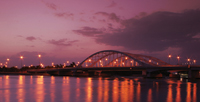
In the past few years, Abu Dhabi has emerged as a high-profile destination for tourists from all over the world.
While the travel and tourism sector has been affected worldwide, Abu Dhabi boasted of a two per cent increase in hotel guests. LAWRENCE FRANKLIN, director of policy and strategy for Abu Dhabi Tourism Authority (ADTA), talks to SHALU CHANDRAN about providing better value to the business customer while developing the emirate’s new leisure segment.
The ADTA posted a two per cent increase on hotel guest numbers in Abu Dhabi in 2009. How did the emirate achieve this in spite of the global downturn?
We have always said that Abu Dhabi has some unique things going for it as a destination for its tourism sector including the government’s ongoing commitment to a strong economy. The fact that government and private sector investment is still happening means all the iconic projects are still happening. Expansion of airport capacity, exhibition and meetings space and on-time completion of hotel developments have all contributed to the overall increase in hotel guests. We have a very strong roll-call of business, leisure sports and now food and culture events and statistics show the substantial impact some of those events have had on overall year-round figures.
We had particularly good performances in the last quarter of the 2009. Events like the Formula One, the FIFA Club World Cup and also the Eid breaks when a lot of UAE nationals spend Eid within the UAE. So those things in combination have helped us have a better year. We were targeting for similar numbers to 2008 but were fortunate enough to see a two-per-cent growth in visitor numbers. We saw an increase in hotel/hotel apartment room capacity from 12,800 rooms at the beginning of the year to 17,500 at the year-end.
 |
|
Franklin…positive |
What were the guest arrival numbers in 2009? Who have been your major source markets?
Close to 1.6 million guests stayed in Abu Dhabi hotels in 2009 racking up some 4,673,494 guest nights. Guest stays in the final quarter grew by 16 per cent year-on-year.
There has been a strong demand in domestic tourism as well which accounted for 42 per cent of hotel guests - a rise of 26 per cent on the previous year.
In the last five years, we have recorded growth in guests with double digit increases every year until 2009. Numbers have doubled since 2004 from 960,000 to more than 1.5 million in 2009.
On the international front, Abu Dhabi’s main source markets for hotel guests were the the UK, 96,709, the US, 67,804, India, 61,241, Germany, 59,667, Egypt, 43,304, France, 34,776, Saudi Arabia, 30,717 and Italy 29,653.
We are already quite active in new markets like China, now with a new office there.
Other markets like Russia, the US and South East Asia are also gaining significance and we hope to see larger guest arrival numbers from these markets.
With more hotel rooms now available, what are your targets for 2010?
We are now targeting 1.65 million hotel guests for 2010, which will be a 10 per cent growth. Further we are still looking to achieve 2.3 million hotel guests and about 24,000 hotel rooms by 2012. Recent accommodation additions on the Yas Island and five-star luxury properties like Fairmont Bab Al Bahr and Park Arjaan have created a more competitive and better-value environment for business travellers. More rooms are due to join Abu Dhabi’s accommodation inventory in 2010 which will boost the leisure tourism segment as well.
 |
|
Abu Dhabi corniche |
Will business tourism / Mice continue to be the emirate’s strongest segment, or are there plans to boost the leisure segment with projects like the Ferrari World opening this year?
Yes, while business will continue to be an important segment for Abu Dhabi, in the long-term we would like to see a half- business half-leisure mix in our guest profile. The significant increase in hotel rooms in Abu Dhabi has given us the opportunity to build the leisure side of the tourism portfolio. When you want to build leisure tourism, you really need to be able to offer some very good value-for-money and some competitive packages. For example, the hotels on Yas Island are shepherding a new approach to packages and are being more aggressive to help build business. By the end of this year, the opening of the huge Ferrari World Abu Dhabi theme park – the world’s largest indoor theme park – will create a significant new leisure-based precinct. By 2012-2013, many of the projects on Saadiyat will begin to roll out, creating culture tourism. Culture tourism again can be seen in two dimensions - the local, intrinsic culture of the emirate and the global culture which is demonstrated with the museums at Saadiyat. The Abu Dhabi Authority for Culture and Heritage (ADACH) is doing a lot of work in terms of promoting the nation’s history and culture. A part of ADACH’s efforts is to preserve Abu Dhabi’s heritage in all its forms, in 2009 ADACH achieved a lot in this regard such as rehabilitating historical buildings and launching initiatives to renovate existing museums and build new ones. The inauguration of Al Jahili Fort was a major step in the effort to rehabilitate the civil heritage of Abu Dhabi.
We have also launched the Gary Player-designed Saadiyat Beach Golf Course and next month will see the launch of the Yas Links golf course. We have also had some third-party endorsements for Abu Dhabi as a leisure destination including Top Ten places to visit in 2010 recommendations from leading travel guides Lonely Planet and Frommer’s.
 |
|
The famous Al Maqta Bridge |
Following the inaugural Formula One last year, how much destination awareness has the event brought for the emirate and how do you see it boosting Abu Dhabi’s tourism industry?
We know that when we are talking about Formula One and Yas Island, we are talking of a global audience of tens of millions of viewers. It has created massive exposure for the emirate. What it has also done is to demonstrate Abu Dhabi’s capability to deliver. What was also heartening was the strong involvement of the Emiratis, particularly with the volunteer programmes. It was the beginning of what will be a long-term engagement of the Emiratis with the tourism sector.
What are your tourism plans for Al Ain in 2010?
Al Ain is a very important part of the overall tourism offer. It is firmly embedded in all our promotional activities in our visitor and business planning guides. Al Ain is always on the
agenda with media visits. There is an organisation now created, called the Eastern Region Development Committee, which is looking at a very comprehensive plan for the social, cultural and economic development of Al Ain. Tourism is a very important part of that plan. As a tourism proposition, Tourism Development & Investment Company is working on a few projects in Al Ain. The former Al Ain Zoo was rebranded in 2009 as the Al Ain Wildlife Park and Resort. A three-phase development plan has been launched and the completed project will occupy more than 900 hectares. When completed in 2011, it will house a resort hotel, residential apartments, restaurants and an amphitheatre.
What is the biggest challenge you are looking to overcome in 2010?
Our biggest challenge is achieving that 10 per cent growth in 2010, realising the leisure tourism proposition, filling those hotels and some new challenges that we have deliberately set for ourselves such as working on sustainability which is an important part of achieving our vision. Emiratisation is an ongoing challenge we are committed to.
Development of infrastructure, from the expansion of airport capacity to increasing exhibition and meeting space, this is another challenge. Cruising is an important segment and a major challenge because you have 2,000 guests entering the city at one go! It is a huge marketing opportunity and we have a cruise strategy which will continue to look at developing Abu Dhabi as a homeport. We see significant potential to develop Abu Dhabi as a cruise destination.
